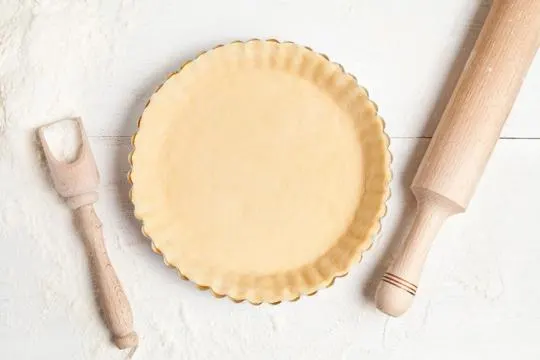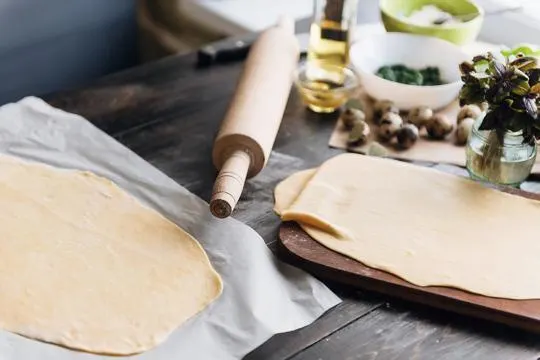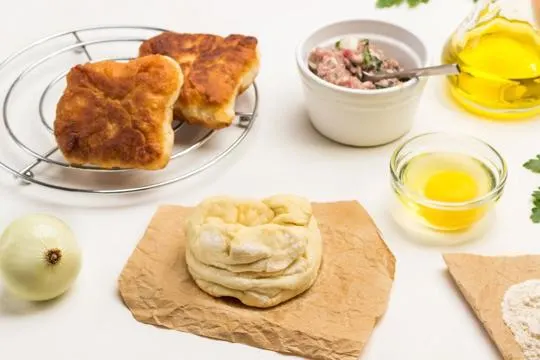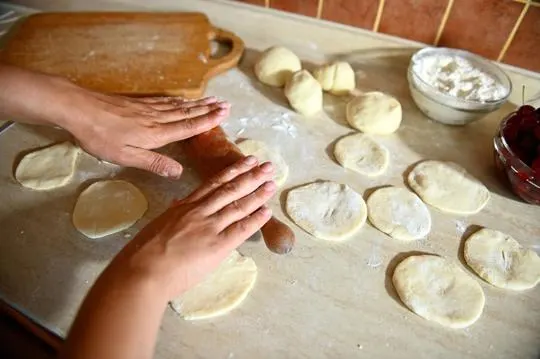Summary of key points
The main difference between pâte sucrée and pâte brisée lies in their composition. Pâte sucrée is a sweet pastry dough made with sugar, butter, flour, and eggs, while pâte brisée is a savory pastry dough made with only butter, flour, and water.
This distinction also affects the texture of each type of dough. Pâte sucrée is crumbly and buttery, making it a great base for tarts or pies with sweet fillings. On the other hand, pâte brisée is more flaky and sturdy, making it ideal for savory dishes like quiches.
For those with a sweet tooth, pâte sucrée is the way to go, but pâte brisée offers more versatility in cooking.
Pâte Sucrée and Pâte Brisée might sound like fancy French words we drop to impress our dinner guests. They’re types of pastry dough, if you haven’t Googled it yet.
One’s sweet, the other, not so much. Our kitchen experiments have proven that choosing the right one can elevate your pie game from “meh” to “wow.”
Ever ended up with a soggy bottom because you picked the wrong pastry? We’ve been there.
Missteps lead to discoveries, though. Here, we’ll guide you through these doughs, highlighting what sets them apart.
It’s all about finding the perfect base for your filling.
What is Pâte Sucrée?

Pâte Sucrée is a type of sweet French pastry dough that is less flaky and more crumbly in texture.
Its name literally translates to “sweet pastry” in English, and it is commonly used as a base for tart shells and other desserts.
What makes Pâte Sucrée unique is its ratio of fat to flour, which leans heavily on the buttery side.
This results in a rich, tender, and slightly sweet dough that pairs beautifully with fruit compotes, custards, and creamy fillings.
Although it may seem intimidating to make, Pâte Sucrée is actually quite simple once you get the hang of it.
Just be sure to chill the dough for at least an hour before rolling it out, and you’ll have a perfectly crispy and delicious pastry ready for your next culinary masterpiece.
What is Pâte Brisée?

Pâte Brisée is a renowned pastry dough in French cuisine.
It stands out for its crumbly texture, ideal for tarts and quiches.
The main ingredients are flour, butter, water and a pinch of salt.
To make it, cut cold butter into the flour until it looks like coarse crumbs.
Then add water to bring it together.
Handle with care and chill before use for its flakiness.
Its versatility allows for sweet and savory fillings, making it a popular pastry recipe all over.
In contrast to other pastry doughs, such as Pâte Sucrée, Pâte Brisée has a neutral flavor.
Its crumbly texture adds contrast to creamy or juicy fillings without overpowering them.
Perfect for both fruit tarts and hearty quiches.
A unique aspect of Pâte Brisée is its lack of sugar in the base recipe.
This gives more flexibility in terms of flavor.
Sweet tarts can still be made by adding sugar to the filling or spices to the dough.
It shines just as much with savory ingredients like cheese, herbs and vegetables.
Key Differences Between Pâte Sucrée and Pâte Brisée

Two pastry doughs – Pâte Sucrée and Pâte Brisée – are delicious baking options.
But what makes them different? Let’s find out.
Texture and Composition
Texture and composition vary between pâte sucrée and pâte brisée.
Pâte sucrée, also known as sweet pastry dough, is delicate and crumbly.
To make it, mix butter, sugar, eggs, flour and sometimes ground almonds.
Pâte brisée, or shortcrust pastry dough, provides a firmer texture with a slight flakiness.
Its ingredients are flour, butter, salt and cold water.
Pâte sucrée’s natural sweetness and tenderness are ideal for tarts or pies.
Its flavor complements fruit fillings like berries or custard-based creations.
Pâte brisée’s sturdy structure can handle heavier fillings like meats or vegetables.
Its flaky texture adds an enjoyable layer to savory dishes.
Both types of pastry dough have uses in pastry making.
Chefs can experiment with flavors and combinations to create extraordinary desserts or savory creations.
Each offers unique textures and compositions that elevate any dish.
So, consider the texture and composition of your pastry dough carefully to make something exceptional.
Sweetness Level and Flavor
Pâte Sucrée and Pâte Brisée differ in sweetness level and flavor.
Pâte Sucrée is known for its sweet and rich taste, perfect for tart crusts and desserts.
On the other hand, Pâte Brisée has a milder sweetness and more neutral flavor, suitable for both sweet and savory recipes.
Pâte Sucrée’s sweetness complements fruit-based fillings and creamy textures.
It elevates the taste of tarts and pies, leaving a pleasant sweetness on the palate.
Pâte Brisée’s neutrality allows it to be used in quiches, meat pies or pot pies, allowing the flavors of the fillings to shine through.
Both pastry doughs bring unique flavors that enhance the overall taste.
To decide which one to use, consider the desired outcome of the recipe – whether you want a sweeter and richer treat or a more adaptable base.
With this knowledge, chefs and bakers can choose the ideal pastry dough for their creations.
Common Uses and Recipes
Pâte sucrée and pâte brisée have common uses and recipes. Let’s cover them.
Pâte sucrée is a sweet pastry dough used as a tart or pie base.
Its buttery taste and slight sweetness make it great for fruit tarts, custard tarts, and meringue pies.
To make it, mix flour, sugar, butter, eggs, and sometimes almond powder.
Chill it, roll it out, press it into a tart shell, and bake.
Pâte brisée is a tasty pastry dough for both sweet and savory dishes.
It has a crumbly texture and rich flavor.
Use it for quiches, savory pies, galettes, and desserts like apple or lemon tart.
Make it by combining flour with cold butter until it forms coarse crumbs.
Then add water and chill in the fridge. Now for the details.
Pâte sucrée is sweeter than pâte brisée, but more delicate and fragile.
Best for smaller pastries that need gentle handling.
Whereas pâte brisée is sturdier and great for heavier fillings like meat or veggies.
Experiment with various flavors and ingredients.
Similarities Between Pâte Sucrée and Pâte Brisée
Pâte Sucrée and Pâte Brisée – two classic French pastry doughs – have some similarities.
They both have a buttery flavor which adds to any sweet or savoury dish.
They also both are made with flour, butter, eggs and a dash of sugar, leading to a tender yet crumbly texture.
It’s important to chill them before use to keep their shape during baking.
Although they share these characteristics, they also differ.
Pâte Sucrée has a sweeter taste due to its sugar and vanilla extract.
It’s commonly used for tart shells and sweet pastries like fruit tarts and custard-filled dishes.
Pâte Brisée has a more neutral flavour since it has no sugar or vanilla.
It’s better suited for savory dishes like quiches or pot pies.
Its strong structure is perfect for heavier fillings.
Factors to Consider When Choosing Between Pâte Sucrée and Pâte Brisée

Choosing between pâte sucrée and pâte brisée involves thinking of several factors.
Pâte sucrée has more sugar, making it sweet and great for desserts like tarts and pies.
Pâte brisée has less sugar or none, used for savory dishes like quiches and meat pies.
Texture makes a difference too.
Pâte sucrée is tender and crumbly, with a richer flavor due to the added sugar.
Pâte brisée is delicate and flaky, perfect for lighter toppings.
The method of preparation differs for each dough.
Pâte sucrée involves creaming butter and sugar together.
Pâte brisée requires cold butter cut into flour until it’s coarse.
The final choice depends on the dish and personal preference.
Knowing the differences between the two pastry crusts will help you pick the right one for your recipe.
Dessert Applications
Pâte sucrée and pâte brisée are two different crusts used for desserts.
Pâte sucrée has a sweet, delicate flavor and crunch.
It’s perfect for tarts like fruit tarts or lemon meringue pie.
Its buttery texture pairs well with fruity flavors.
Pâte brisée has a neutral taste and a crumbly texture which is great for pies like apple or pumpkin pie.
Its ability to hold moist fillings makes it a good choice.
Pâte sucrée’s sweetness and crispness bring out the flavors of fruit tarts.
Its sturdiness allows for easy slicing.
Pâte brisée’s neutral taste complements pies with rich fillings.
The crumbly texture adds a delightful texture that contrasts the filling.
Pâte brisée holds its shape while enhancing the taste.
Both crusts can be used for decorative designs.
Pâte sucrée is firm enough to cut out intricate patterns or fancy cut-outs.
Pâte brisée can also be molded or brushed with egg wash.
Savory Dishes
Savory dishes – known for their rich, robust flavors – are a delightful addition to any meal.
From succulent meats to hearty veggie creations, these savory delights tantalize taste buds and leave us wanting more.
Precision and care go into crafting these dishes, with chefs balancing flavors using herbs and spices.
What sets savory dishes apart is their ability to bring components together seamlessly.
Whether it’s tender meat with tangy sauces or crisp vegetables with creamy dressings, every element works in harmony.
Cooking techniques employed in savory dishes are key to their appeal.
Grilling, roasting, braising – each method brings out unique flavors and textures that make these dishes stand out.
Plating these creations beautifully also enhances their taste and visual appeal.
Savory dishes offer a world of culinary exploration and satisfaction.
Endless possibilities and combinations await to be discovered, captivating palates and inspiring kitchen experiments.
Handling and Rolling Ease
Pâte sucrée and pâte brisée both have unique qualities when it comes to handling and rolling.
Pâte sucrée is delicate and crumbly, making it a bit more difficult to manage.
But this gives it a melt-in-your-mouth texture, great for sweet tart shells.
Pâte brisée, on the other hand, is sturdier and more flexible, which makes it perfect for shaping into various forms.
It’s also ideal for savory dishes like quiches and pot pies.
It all comes down to personal preference and desired outcome.
To make beautiful and delicious pastries, mastering the art of handling and rolling is essential.
Conclusion
The subtle differences between pâte sucrée and pâte brisée, as well as the appropriate uses for each kind of dough, can be a little confusing for home bakers.
Although both are used to make tarts, pies, and their bases, it is important to keep in mind that these two types of dough have distinct textures and flavors that must be taken into account.
Pâte sucrée is a sweet tart pastry dough with a short texture that has added sugar and egg yolks for flavor; pâte brisée is a savory pie crust with a crumbly texture which uses butter or vegetable shortening for flavor.
Together they form the foundation quite literally of so many wonderful desserts.
So which one should you use? That’s totally up to you but with the understanding of the difference between pâte sucrée and pâte brisée it will be easier for you to decide.

Leave a comment